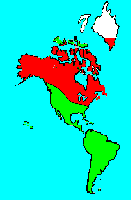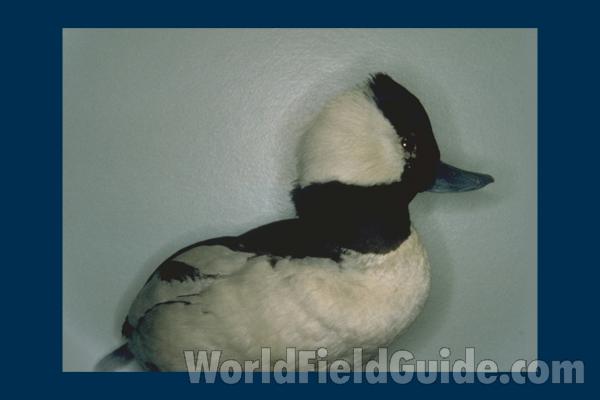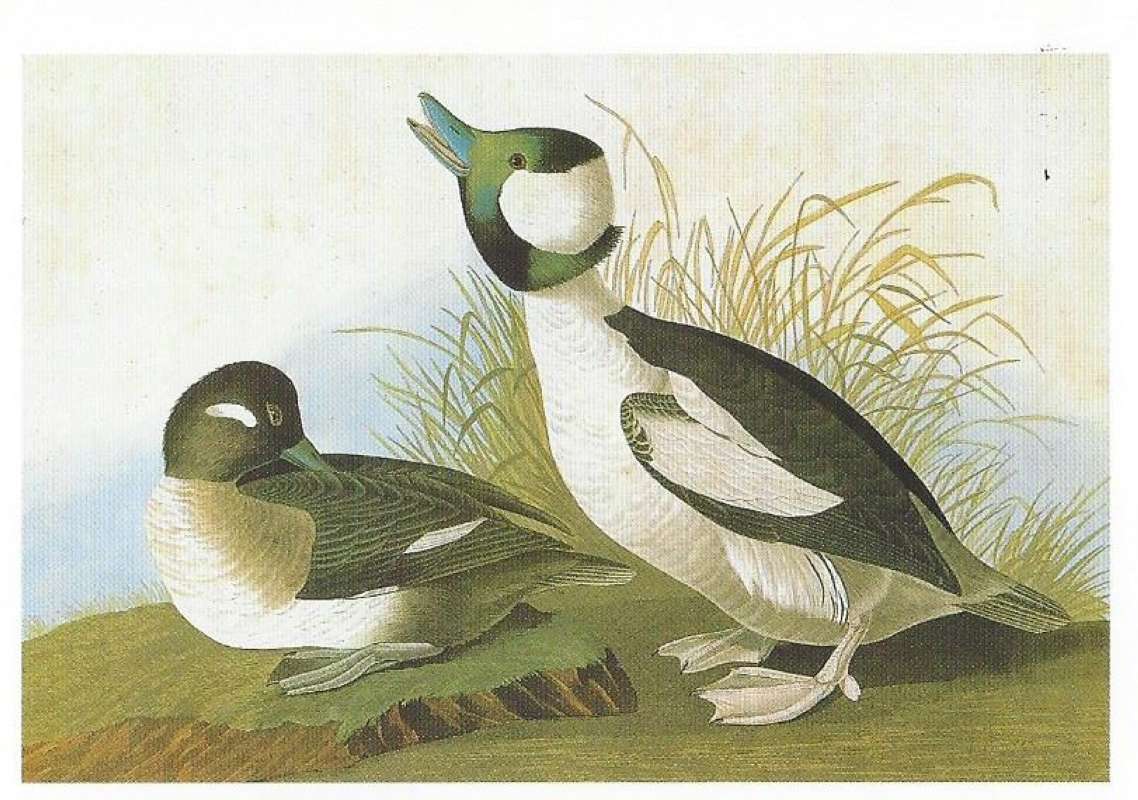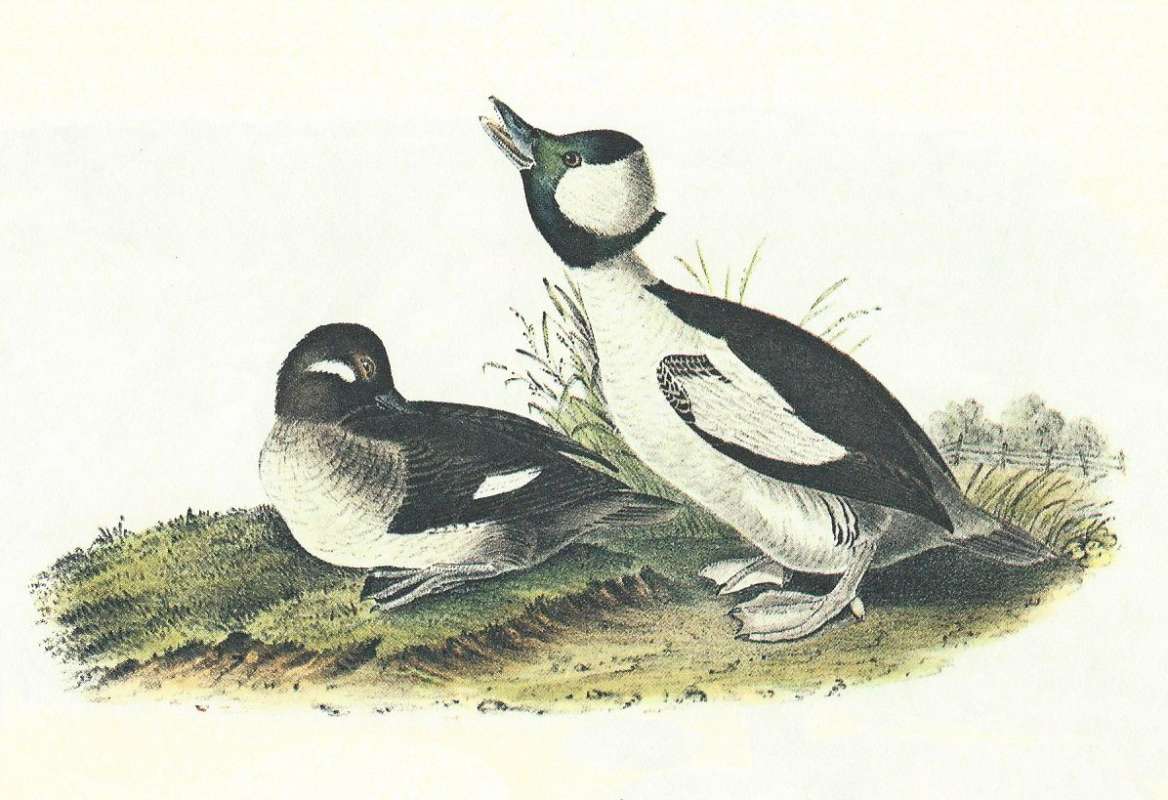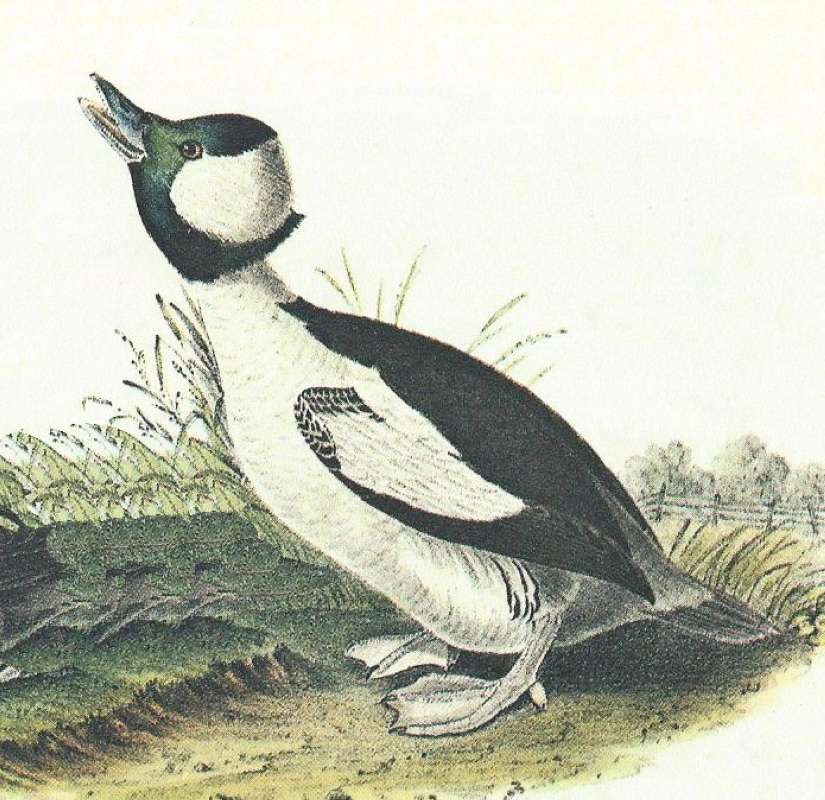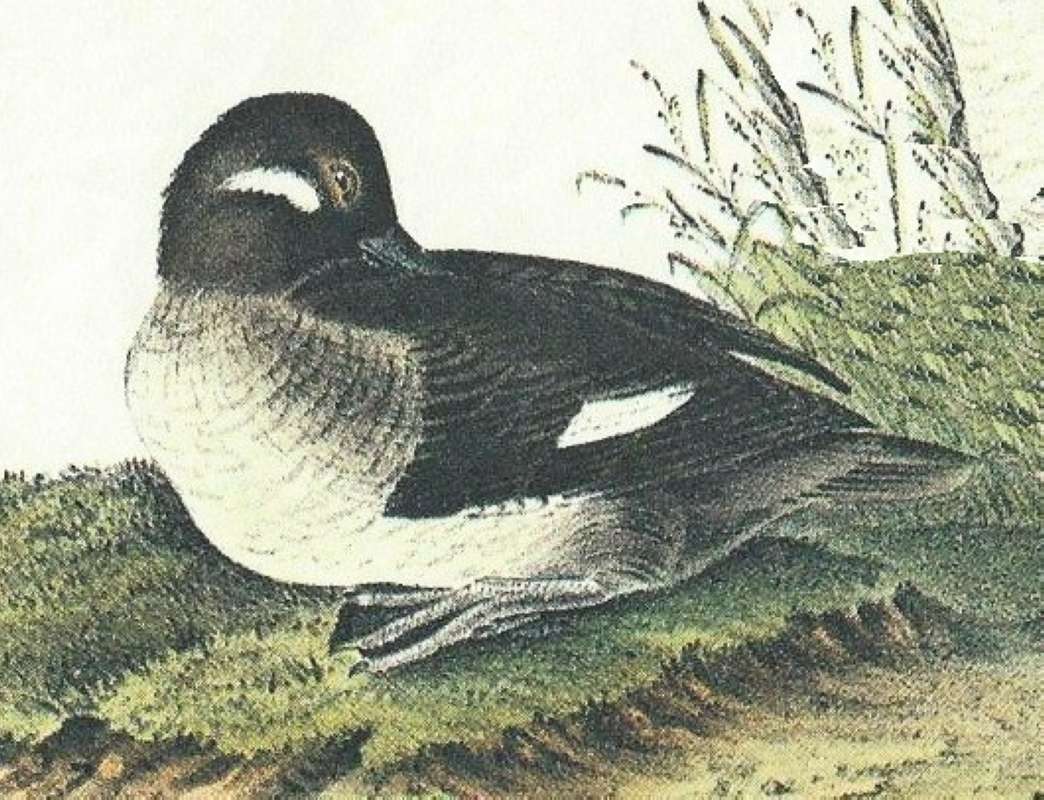SPECIES INFO
Bufflehead (Bucephala albeola) breeds in most of Canada and in the Rocky Mountains of the United States. The white underside and unique black head with a large white patch going from the eye to the back of the head helps identify this small duck. It generally measures from thirteen to fifteen inches.
There are no subspecies.The goldeneye and bufflehead genus (Bucephala) is found in the Northern Hemisphere. There are three species. These are small ducks from about 14 to 21 inches in length. These all show black and white wings dorsally in flight. The goldeneye males have dark heads marked with a white areas near the base of the bill. The goldeneye females have reddish heads. The bufflehead male has a dark head with a white area from the eye to the top of the head. The female bufflehead has a brownish head marked with a white spot behind and below the eye.
The Diving Ducks (Subfamily Aythyinae) contains the ducks known as pochards. The following twenty-five species are assigned to this subfamily:
Aythya affinis - Lesser Scaup - N. America
Aythya americana - Redhead - New World
Aythya australis - White Eye - Australia
Aythya baeri - Baer's Pochard - Eurasia
Aythya collaris - Ring Necked - N. America
Aythya ferina - Scaup - Old world
Aythya fuligula - Tufted - Old World
Aythya innotata - Mdgscr Pochard - EXTINCT Madagascar
Aythya marila - Greater Scaup - Holarctic
Aythya novaseelandiae - N. Zlnd Scaup - Australian
Aythya nyroca - Ferruginous - Old World
Aythya valisineria - Canvas Back - N. America
Bucephala albeola - Bufflehead - N. America
Bucephala clangula - Goldeneye - Holarctic
Bucephala islandica - Barrow's - N. America
Camptorhynchus labradorius - Labrador - EXTINCT Canada
Clangula hyemalis - Old Squaw - N. Hemisphere
Histronicus histronicus - Harlequin - N. Hemisphere
Melanitta fusca - Velvet Scooter - N. Hemisphere
Melanitta nigra - Common Scooter - N. Hemisphere
Melanitta perspicillata - Surf - N. Hemisphere
Somateria fischeri - Spectacled Eider - N. Hemisphere
Somateria mollissima - Common Eider - N. Hemisphere
Somateria spectabilis - King Eider - N. Hemisphere
Polystica (Somateria) - stelleri - N. Hemisphere
Duck and Geese Family (Family Anatidae) contains the familiar ducks and geese. There are about 155 species in this family. (Excluding the 9 Whistling Ducks or 164 including them)
Some forms are sometimes regarded as species, and at other times are regarded as subspecies. An attempt has been made here to include as species those forms that frequently appear both ways (Anas crecca/carolinensis, for example).
It is also difficult to exactly count the species, as some authors ignore recently extinct species, and other authors include them in their counts. The following recent extinctions have also been included in the lists that follow as these may cause problems for the taxonomist trying to tie out exact counts:
Labrador Duck - Camptorhynchus labradorius
Korean Shelduck - Tadorna cristata
Madagascan White-Eye - Aythya innotata
Auckland Merganser - Mergus australis
Pink Headed Duck - Rhodonessa caryophyllaca
Sheldgoose-Mauritius - Alopochen mauritianus
Sheldgoose-Reunion - Alopochen kervazoi
This family is usually divided into several tribes as it helps the taxonomist and student alike in learning the many species. There is no agreement upon the natural subdivisions of this family. The following divisions were arbitrarily chosen and placed into an arbitrary order:
Surface Ducks - Anatinae - 64 species
Geese and Swans - Anserinae - 24 species
Freckled Duck - Stictonettinae - 1 species
Tadorna Group - Tadorninae - 25 species
Diving Ducks - Aythyinae - 25 species
Mergansers - Mergini - 7 species
Ruddy Ducks - Oxyurinae 9 species
Total 155 species
Waterfowl Order (Order Anseriformes) contains three different families of rather divergent appearance and habitat. The South American (Neotropical) Screamers contains three species. The Magpie-Goose family contains one species. And the worldwide ducks and geese (including the whistling ducks) contains about 164 species to total about 168 species in the order. Actually, at least seven of Anseriformes species are recently extinct, and different authors count these differently.
We herein separate the whistling ducks (Dendrocygninidae) into a separate order and family.
The members of this order have three foreward pointing toes that are webbed. The hind toe is free, but very small. The top bill is wide, and the lower bill is smaller. The diving ducks can have narrow bills.
Aves contains about 8,650 different species of living birds known to science. Each year about one new species is discovered in some remote rain forest or remote island. In addition, scientists have been raising many subspecies to full species status which may raise the species count to 10,000. Birdlife recognizes 10,027 species as of 2011.
However, each year about one species goes extinct. The rate of extinction is increasing, and the rate of new discovery is decreasing, so that the number of bird species will soon begin to decline rapidly. Although different taxonomists would organize the birds differently, there are approximately twenty-seven orders of birds. These orders are broken down into about one hundred and fifty-five different families.
Recent research of the genetic structure of some of the shore birds and owls would indicate that the present organization of orders and families should have some modification.
The birds are a worldwide group of animals that are characterized by having the front limbs modified into wings that are used for flying. Perhaps the most unique feature of the birds is the feathers. These feathers are made up of a central support called a quill and a series of small filaments that are hooked together as barbs.
For many years it was believed that Archaeopteryx discovered in Bavaria was the oldest bird from about 150 million years ago. However, in l986, Sankar Chattterjee, a Texas paleontologist, reportedly discovered a bird in the genus Protoavis that lived about 225 million years ago.
When this project was begun in 1978, we used Austin & Singer for bird taxonomy. Since then, we have adopted many changes, but have kept some older concepts that are still found widely in the literature. Recently, we have used Clements and Howard & Moore. Very recently, we have used Monroe and Sibley for the higher taxonomy of the perching birds.
Backboned Animals (Phylum Chordata) are the most advanced group of animals on earth. These animals are characterized by having a spinal cord or backbone. Most members have a clearly defined brain that controls the organism through a spinal cord. Fish, amphibians, reptiles, birds, and mammals are in this phylum.
Currently, some taxonomists believe that the fish should be divided into two groups (sharks and regular fishes) and that there are some other primitive groups in the phylum such as hagfish or lampreys.
Animal Kingdom contains numerous organisms that feed on other animals or plants. Included in the animal kingdom are the lower marine invertebrates such as sponges and corals, the jointed legged animals such as insects and spiders, and the backboned animals such as fish, amphibians, reptiles, birds, and mammals.
